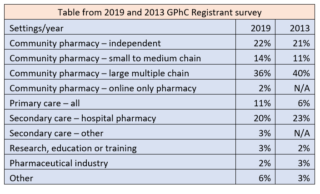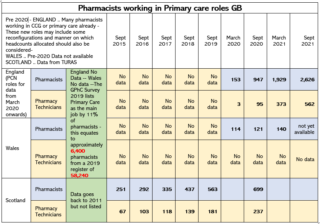There has been much talk recently about additional roles created for clinical pharmacists in primary care and GP settings taking pharmacists away from community pharmacies, and thus creating a “shortage” which is being claimed to be the cause of closures in some community pharmacies.
Pharmacists have been employed in primary care for well over a decade, usually in centrally resourced teams employed by PCTs (and then CCGs) and usually associated with so called “medicines management” functions. This direct employment by NHS organisations (or Health Board equivalents) still exists, but many pharmacists are now also being employed by PCNs or GP surgeries for patient facing clinical roles, often supported by NHS funding in the form o f the Additional Roles Reimbursement Scheme (ARRS)
Pharmacists working in primary care is nothing new, and we are merely witnessing an expansion in this sector and specifically in the role as patient facing clinical pharmacists based in GP surgery settings. This development has been a long-term aim of the profession and is recognition of the contribution that pharmacists can make to patient outcomes and developing capacity through effective skill mix. The PDA believe this should be seen as a positive evolution for pharmacy careers and are disappointed by some parts of the sector who see GP practice as competition for pharmacists. In Scotland, the representative body for employers, Community Pharmacy Scotland, even suggested that pharmacists be prevented from taking jobs in GP practice.
To establish if these extra career opportunities for pharmacists may have caused a shortage we need to look at the evidence, here are the numbers in a methodical, rational and considered manner.
The GPhC registrant surveys in 2013 and 2019
This was a comprehensive and robust survey conducted in 2019 and one specific table published was based on the sector of work.

This table clearly shows the trend in workforce sector distribution moving towards primary care. But this shift has been more than accommodated by rising numbers entering the GPhC register.
According to the 2013 survey, 6% of pharmacists described primary care as their main role. This would equate to 2,844 of 47,407 pharmacists which were on the register in March 2013.
In the 2019 survey, 11% of pharmacists described primary care as their main role. This equates to 6,192 of 56,288 pharmacists on the register in March 2019, an increase of 3,348 roles over the 6-year period.
In that same period, the overall number of pharmacists on the GPhC register increased by 8,881.
The growth in the number of registered pharmacists in Great Britain
There has been a significant increase in the number of pharmacists over the last decade and the data about student numbers indicates that this annual increase in numbers will continue.

The delay in the registration exam due to Covid-19 means that the numbers for 2021 showed a small decline in the register, but there is an expected large jump in 2022 which takes into account the position once all the delayed exams have taken place and results issued.
This trendline has been moving in one direction for well over 30 years with the exception of one year, this was the transitional year for when the 3-year BPharm became the 4-year MPharm.
The predicted 2024 GPhC data for the number of registered pharmacists is based on students already enrolled at University and takes into account existing dropout rates during university and existing fail rates at the pre-reg exam.
The data about recent numbers recruited into GP/PCN/Health board settings
A central part of the drive to increase capacity in primary care has been to ensure that doctors have well trained teams to support them, including pharmacists who can prescribe and work as part of a multi-disciplinary team.
The drive to increase capacity in GP surgeries and especially around the workload that could transition from GPs to pharmacists (for example managing patients with long term conditions such as diabetes or asthma) is an ongoing ambition.
The BMA anticipates a metric of one patient facing pharmacist per 10,000 patients working in GP settings in 2024. The phasing of this expansion is expected to run into 2024.
If we use a similar phasing across England, Scotland and Wales with a similar metric of 1 clinical pharmacist per 10,000 patients then this would create a need for around 6,700 pharmacists across the three nation’s population of around 67 million. For ease of calculations let us say 7,000 patient facing clinical pharmacist posts will be in place during 2024.
The data table below shows the number of pharmacists that are already employed as approximately 3,465 full time equivalent positions (probably more as the Wales and Scotland data is for 2020 and does not reflect any additional posts that may have already been filled).
This then leaves approximately 3,500 additional clinical pharmacist roles to fill in the period to 2024 (i.e. 7,000 less 3,465 in place already).
This data from the registration table above clearly shows that there will be an additional 5,570 registered pharmacists in the period 2021 to 2024 which will enable all the new clinical pharmacist roles to be filled without impacting other sectors.
In addition, it should also be noted that community pharmacy closures of approximately 500 registered pharmacies over the period 2015-2024 will also have released capacity of at least 500 full-time equivalent pharmacists into the wider network.

Discussion
The information in this article around pharmacist numbers registered and deployed is sourced from publicly published data by the pharmacy regulator and NHS workforce organisations in the British nations. It clearly shows that the increase in registrant numbers can accommodate the extra numbers being employed as clinical pharmacists GP settings both now and as planned.
In relation to any perceived shortages, the question remains around why some community pharmacy owners are apparently unable to recruit pharmacists. In a recent community pharmacy sector report employers recognised the issue with recruitment and retention included pay and working conditions.
The data around pharmacy closures due to alleged lack of pharmacist availability certainly seems to indicate that some pharmacy companies are temporarily closing some of their pharmacies due to what they claim is a “shortage”. However, the PDA suggest that this is more likely to be an issue around their inability to attract pharmacists. We encourage those employers to consider:
- Their organisational culture and management practices
- The reduction in purchasing power of pharmacist salaries over recent years
- The staffing levels they allocate to their pharmacies; are there sufficient number of competent support staff to safely operate the branch and provide all services?
- The level of investment and maintenance in their premises, what is the physical environment pharmacists are expected to work within?
- What impact does stress and lack of breaks in the pharmacist’s day have on their wellbeing?
Finally, those pharmacy companies struggling most to recruit pharmacists should ask themselves why other employers seem to be able to recruit enough pharmacists to keep their pharmacies open?
Read more
- Employers’ report into pharmacy workforce challenges does not address their basic responsibilities
- Community Pharmacy Scotland seeks to prevent pharmacists from securing GP practice-based roles
- Concerns about the impact of automation and online pharmacy provision on patient safety and pharmacy practice
- The importance of differentiating professional and technical aspects of pharmacy
- Inclusion on shortage occupation list demonstrates how there is something broken in regards to pharmacist pay rates
- Community Pharmacy employers try to lower salary expectations of new pharmacists
- Myth of pharmacy shortage
- PDA releases 2020 patient safety survey results
- Community pharmacists acting together to improve pay
Related link
PDA’s Safer Pharmacies Charter
Not yet a PDA member?
If you have not yet joined the PDA, we encourage you to join today and ask your colleagues to do the same.
Membership is FREE to pharmacy students, trainee pharmacists and for the first three months of being newly qualified.
Read about our key member benefits here.